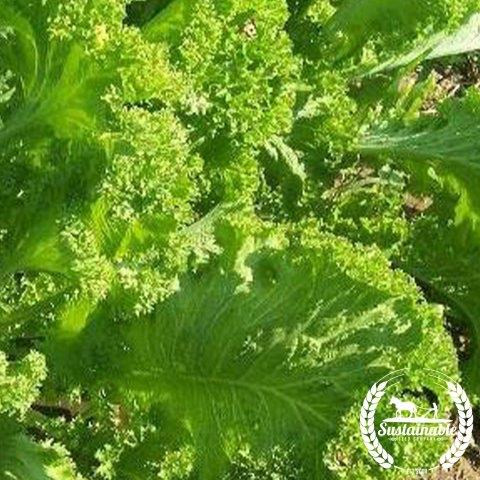You may find yourself with fluctuating amounts of sunlight throughout your yard for a number of reasons.
Don’t worry, you can still have a great summer garden. Shaded areas can actually help you extend your gardening season as it provides cooler temperatures through the heat of the summer.
Here we have provided you a list of the most common garden plants for shaded areas along with their required hours of sunlight.
The more indirect or filtered the light available is, the more you will want to make plans with the greater hours of light recommended in mind.
Shade Varieties
While some of the most popular fruit and vegetable seeds include full-sun varieties such as tomato, pepper, melon, and cucumber, there are a wide selection of crops that only require a minimum of sunlight to produce in northern and shaded gardens.
Even the most heat tolerant and full sun varieties still benefit from shade in grow zones with unforgving midsummer temperatures.
Salad Greens
Leafy Greens
Herbs
Short Day Onions
Root Vegetables
Brassicas
Legumes
Understanding Sunlight Requirements
The amount of light you have is one of the most important factors in growing a garden. There are different kinds of light that will affect your plants differently. They are direct, filtered, and dappled.
Direct/Full Sun - 6+ hours of sunlight between 10am and 6pm. This is required for most fruit and vegetable growing, however there are exceptions. If you live in a northern climate you will want to plan for 8+ hours because of the decreased intensity.
Partial Sun/Shade - 3 to 6 hours of light between 10am and 6pm. This means that your planting area is shaded for part of the day whether by a building or other plant material. If it is specifically being filtered by plant material it is considered dappled light.
Full Shade - No direct sun or reflected light. Because there is less than 3 hours of light, fully shaded areas are not good for vegetable growing. However, there are a few ornamental plants that will thrive in these areas.

Importance of Soil in Shaded Areas
The soil conditions will determine much of your success in gardening. The perfect soil conditions will include a rich nutrient content, looseness, drainage, and air circulation. There are several things you can do to adjust the soil you currently have.
Nutrient Content - The soil is the source of all the nutrients your plant will take up throughout its growth. One of the best amendments you can make is to add organic matter. Organic matter is carbon based compounds found in nature. These can include sawdust, mulch, peat moss, manure, grass, and compost (once living plant material that has decayed). It is the best amendment because it actually improves every other soil condition as well. A quick way to tell if your soil has a lot of organic matter is to observe the soil color. Usually darker soils have a higher organic matter content.
Loose Vs. Compact Soil - Ideal soils are loose and easily workable. When the soil has a high clay content it becomes more difficult to manipulate because the shape of individual clay particles is flat. This causes the particles to stack on top of each other leaving little pore space. To fix this add some sand to your soil as well as organic matter. The combination will provide more pore space allowing for better root development as well as water drainage. Compact soil is undesirable because it prevents root spread and can lead to disease if the soil remains too wet for too long. The weight of the soil acts as a natural barrier for growth.
Water Drainage - Because plants need oxygen as well as water taken up from their roots it is important for excess water to have a place to go. Naturally soil will develop a tunnel like system because of the particles it is made up of. Sand, silt, and clay are different sizes thus creating crevices for water to flow through. However, if you have a higher concentration of one of these materials you may start to see some compaction or water collecting. To fix this you can add perlite, sand, compost, mulch, or vermiculite as an amendment. These materials will provide greater pore space allowing excess water to drain away and better airflow to your root system.
Air Circulation - Soil is more than dirt and water. Air plays an important role in delivering nutrients to your plants. Millions of microorganisms live in your soil tirelessly working to convert nutrients into forms usable by your plants. Specifically, they live in the pore space. Without this space, whether it be filled with soil particles or water, your plants will not thrive. This is why the balance between water retention, drainage, and dryness is so important. While watering your plants is very important, you should do it with the mindset that you are really allowing them to dry and watering when needed. When it comes to growing plants in shaded areas, watering too much is a common problem.
Water Needs
Because less water is evaporated in shaded areas you will need to observe how long it takes your soil to dry out.
To check your soil to see if it is time to water again just scrape the soil with a finger down about an inch. If you can feel the water it needs to dry out some more. The soil should be slightly moist and easy to break apart.
Because shaded areas tend to be so much wetter than sunny areas it is important to allow your soil to dry a bit between watering.
One of the best watering methods to accommodate this issue is a drip irrigation system. By dripping water to the ground you can prevent mold and fungal issues while not overwatering.

Pests
One of the biggest problems with gardening in partial sunlight is the increased likelihood of pests being present. Usually an increased pest presence can be an indicator of a soil issue.
If your soil is too wet you will start to see more insects and diseases appearing. This is why it is so important to be aware of the type of soil you have and how much you are watering.
With regards to vegetable gardening in the shade, you are most likely to see pests such as aphids, slugs, snails, fungus gnats. To prevent pest problems you can utilize the benefits of companion planting.
Specific plants, especially those with a strong fragrance often deter specific pests. Some of the best plants for this are mint, lemon thyme, lemon balm, chives, garlic, marigolds, and chrysanthemums.
If you are having issues with pests we recommend visiting our Pest Troubleshooting Guide for help in identifying the problem and guidance on your options moving forward.
Shade Garden Ideas

For areas that are shaded by trees, plant in the spring when trees are just starting to bud out.
Your seeds will still be able to get the needed sunlight for their initial growth phase.
As the tree puts on leaves throughout the summer it will provide more shade and prevent early bolting from warming temperatures.
For later harvesting, plant again in the late summer while the temperatures are warm enough for good germination and root development but the fall temperatures will allow for continued growth while the thinning leaves will provide the needed access to sunlight.




















































